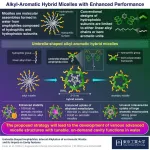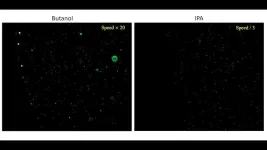(Press-News.org) A surprisingly low amount of methane and a super-sized core hide within the cotton candy–like planet WASP-107 b.
The revelations, based on data obtained by the James Webb Space Telescope, mark the first measurements of an exoplanet’s core mass and will likely underpin future studies of planetary atmospheres and interiors, a key aspect in the search for habitable worlds beyond our solar system.
“Looking into the interior of a planet hundreds of light-years away sounds almost impossible, but when you know the mass, radius, atmospheric composition, and hotness of its interior, you’ve got all the pieces you need to get an idea of what's inside and how heavy that core is,” said lead author David Sing, a Bloomberg Distinguished Professor of Earth and Planetary Sciences at Johns Hopkins University. “This is now something we can do for lots of different gas planets in various systems.”
Published today in Nature, the research shows the planet has a thousand times less methane than expected and a core 12 times more massive than Earth’s.
A giant planet wrapped by a scorching atmosphere as fluffy as cotton, WASP-107 b orbits a star about 200 light-years away. It is puffy because of its build: a Jupiter-sized world with only a tenth of that planet’s mass.
Even though it has methane—a building block of life on Earth—the planet is not considered habitable because of its proximity to its parent star and lack of a solid surface. But it could hold important clues about late-stage planetary evolution.
In a separate study published today in Nature, other scientists also spotted methane with the Webb telescope and provided similar insights about the planet’s size and density.
“We want to look at planets more similar to the gas giants in our own solar system, which have a lot of methane in their atmospheres,” Sing said. “This is where the story of WASP-107 b got really interesting, because we didn’t know why the methane levels were so low.”
The new methane measurements suggest the molecule transforms into other compounds as it flows upward from the planet’s interior, interacting with a concoction of other chemicals and starlight in the upper atmosphere. The team also measured sulfur dioxide, water vapor, carbon dioxide, and carbon monoxide—and found WASP-107 b has more heavy elements than Uranus and Neptune.
The profile of the planet’s chemistry is starting to reveal key pieces in the puzzle of how planetary atmospheres behave in extreme conditions, Sing said. His team will conduct similar observations over the next year on an additional 25 planets with the Webb telescope.
“We had never been able to study this mixing process in an exoplanet atmosphere in detail, so this will go a long way in understanding how these dynamic chemical reactions operate,” Sing said. “It’s something we definitely need as we start looking at rocky planets and biomarker signatures.”
Scientists had speculated that the planet’s overinflated radius resulted from a source of heat inside, said Zafar Rustamkulov, a Johns Hopkins doctoral student in planetary science who co-led the research. By combining atmospheric and interior physics models with Webb’s data of WASP-107 b, the team accounted for how the planet’s thermodynamics influences its observable atmosphere.
“The planet has a hot core, and that heat source is changing the chemistry of the gases deeper down, but it's also driving this strong, convective mixing bubbling up from the interior,” Rustamkulov said. “We think this heat is causing the chemistry of the gases to change, specifically destroying methane and making elevated amounts of carbon dioxide and carbon monoxide.”
The new findings also represent the clearest connection scientists have been able to make about the interior of an exoplanet and the top of its atmosphere, Rustamkulov said. Last year the Webb telescope spotted sulfur dioxide about 700 light-years away in a different exoplanet called WASP-39, providing the first evidence of an atmospheric compound created by starlight-driven reactions.
The Johns Hopkins team is now focusing on what might be keeping the core hot, and expects forces might be in play similar to those causing high and low tides in Earth’s oceans. They plan to test whether the planet is being stretched and pulled by its star and how that might account for the core’s high heat.
Other study authors are Daniel P. Thorngren and Elena Manjavacas of Johns Hopkins University; Joanna K. Barstow of the Open University; Pascal Tremblin of Université Paris-Saclay; Catarina Alves de Oliveira, Stephan M. Birkmann, and Pierre Ferruit of the European Space Agency; Tracy L. Beck, Néstor Espinoza, Amélie Gressier, Marco Sirianni, and Jeff A. Valenti of the Space Telescope Science Institute; Ryan C. Challener of Cornell University; Nicolas Crouzet, Giovanna Giardino, and Nikole K. Lewis of Leiden University; Elspeth K. H. Lee; Roberto Maiolino of University of Cambridge; and Bernard J. Rauscher of NASA Goddard Space Flight Center.
This research is based on data obtained from the Space Telescope Science Institute, which is operated by the Association of Universities for Research in Astronomy Inc., under NASA contract NAS 5-03127.
END
Webb Telescope offers first glimpse of an exoplanet’s interior
Methane found in WASP-107 b reveals core mass, turbulent skies
2024-05-20
ELSE PRESS RELEASES FROM THIS DATE:
Alkyl-aromatic hybrid micelles formed from emergent umbrella-shaped molecules
2024-05-20
Micelles assemble in water from amphiphilic molecules, composed of hydrophilic and hydrophobic frameworks. They can be found all around us, for example in soaps, detergents, and shampoos. Their main application is the water-solubilization of insoluble molecules through encapsulation into hydrophobic cavities. These cavities are conventionally composed of linear alkyl-chains, providing good interactions with alkyl-based guests, yet poor interactions with aromatic compounds. In addition, the rather weak intermolecular alkyl-alkyl type ...
First study from the African Ancestry Neuroscience Research Initiative identifies key genes in the brain that account for higher rates of some brain disorders in Black Americans
2024-05-20
BALTIMORE, Md. (May 20, 2024) – Scientists seeking to counter the neglect of African Americans in neuroscience research have found evidence that genetic ancestry is responsible for the increased prevalence of certain neurological disorders, such as Alzheimer’s disease and stroke, and decreased prevalence of others, including Parkinson’s disease, in Black Americans, according to new research published May 20 as the June cover story in the journal Nature Neuroscience.
In contrast, the scientists from the Lieber Institute for Brain Development did not find evidence that genetic ancestry is responsible for differences in the ...
NIH awards Coast-to-Coast Consortium $5.6 million for All of Us Research Program
2024-05-20
Researchers at the University of California San Diego have been awarded a $5.6 million grant through the Coast-to-Coast Consortium (C2C) to further their pioneering efforts with the National Institutes of Health's (NIH) All of Us Research Program.
The award is designated to facilitate participant engagement, enrollment, data collection, and retention. C2C will build on the foundation set by the UCSD-led California Precision Medicine Consortium (CAPMC), established in 2018, which enrolled more than 65,500 participants to the program.
This award follows the program's ...
Ben-Gurion University scientist hunts for drug candidate to treat brain tumors
2024-05-20
BEER-SHEVA, Israel, May 20, 2024 – When you disable the brakes on a race car, it quickly crashes. Dr. Barak Rotblat wants to do something similar to brain cancer cells. He wants to disable their ability to survive glucose starvation. In fact, he wants to speed the tumor cells up, so they just as quickly die out. It is a novel approach to brain cancer based on a decade of research in his lab.
He and his students' and co-lead researcher Gabriel Leprivier of the Institute of Neuropathology at University Hospital Düsseldorf ...
New Health Blueprint maps healthier future for rural, underserved Southwest Virginia
2024-05-20
A sweeping new Health Blueprint for Southwest Virginia highlights the grave health challenges that grip the rural region but also proposes solutions to help residents live longer, healthier lives.
The Blueprint was assembled by the University of Virginia College at Wise’s Healthy Appalachia Institute, the Southwest Virginia Health Authority, UVA Health’s Center for Telehealth and a coalition of residents and regional healthcare providers. The document identifies priority health concerns for the three health districts in the southwestern corner of Virginia: Lenowisco, Cumberland Plateau and Mount Rogers. These are areas ...
Survival benefit associated with participation in clinical trials of anticancer drugs
2024-05-20
About The Study: Many studies suggest a survival benefit for cancer trial participants. However, these benefits were not detected in studies using designs addressing important sources of bias and confounding. Pooled results of high-quality studies are not consistent with a beneficial effect of trial participation on its own.
Quote from corresponding author Jonathan Kimmelman, Ph.D.:
“Many physicians, policymakers, patient advocates, and research sponsors believe patients have better outcomes when they participate in trials, even if they are in the comparator arm. Educational ...
Expanding on the fundamental principles of liquid movement
2024-05-20
Fukuoka, Japan—From the rain drops rolling down your window, to the fluid running across a COVID rapid test, we cannot go a day without observing the world of fluid dynamics. Naturally, how liquids traverse across, and through, surfaces are a heavily researched subject, where new discoveries can have profound effects in the fields of energy conversion technology, electronics cooling, biosensors, and micro-/nano-fabrications.
Now, using mathematical modeling and experimentation, researchers from Kyushu University’s Faculty of Engineering have expanded on a fundamental principle in fluid dynamics. Their new findings may ...
Chemical Insights Research Institute partners with Duke University and the East-West Center to examine dust and ash from devastating Hawai’ian wildfires
2024-05-20
ATLANTA - Chemical Insights Research Institute (CIRI) of UL Research Institutes applies cutting edge technologies to evaluate the toxicity of burn-impacted land areas affected by the August 2023 Lahaina wildfires. Created with CIRI research partners from Duke University and the East-West Center (EWC) in Hawai’i, the study known as Lahaina Environmental Assessment Project (LEAP), will collect and analyze residual dust, soil and ash samples from properties affected by the fires. These residues, including fine dust, ...
NCCN publishes new resource for patients with intestinal cancer type most have never heard of before diagnosis
2024-05-20
PLYMOUTH MEETING, PA [May 20, 2024] — The National Comprehensive Cancer Network® (NCCN®) today announced publication of new NCCN Guidelines for Patients®: Small Bowel Adenocarcinoma. This free resource for people facing cancer and caregivers is focused on a rare cancer type that typically occurs in the small intestine, where routine screening is impossible, even for high-risk individuals. The small amount of patient information that exists for this cancer type tends to combine it with other cancers of the small intestine (such as sarcomas, neuroendocrine tumors, or lymphomas) despite very different treatment approaches and results.
The NCCN Guidelines for Patients: ...
Subduction zone splay faults compound hazards of great earthquakes
2024-05-20
Groundbreaking research has provided new insight into the tectonic plate shifts that create some of the Earth’s largest earthquakes and tsunamis.
“This is the first study to employ coastal geology to reconstruct the rupture history of the splay fault system,” said Jessica DePaolis, postdoctoral fellow in Virginia Tech's Department of Geosciences. “These splay faults are closer to the coast, so these tsunamis will be faster to hit the coastline than a tsunami generated only from ...
LAST 30 PRESS RELEASES:
House sparrows in northern Norway can help us save other endangered animals
Crohn's & Colitis Foundation survey reveals more than 1/3 of young adults with IBD face step therapy insurance barriers
Tethered UAV autonomous knotting on environmental structures for transport
Decentralized social media platforms unlock authentic consumer feedback
American Pediatric Society announces Vanderbilt University School of Medicine as host institution for APS Howland Visiting Professor Program
Scientists discover first method to safely back up quantum information
A role for orange pigments in birds and human redheads
Pathways to net-zero greenhouse gas emissions for Southeast Asia
A JBNU–KIMS collaborative study on a cost-effective alloy matches superalloys for power plants and energy infrastructure
New study overturns long-held model of how plants coordinate immune responses.
New AI model predicts disease risk while you sleep
Scientists discover molecular ‘reshuffle’ and crack an 80-year-old conundrum
How stressors during pregnancy impact the developing fetal brain
Electrons lag behind the nucleus
From fungi to brain cells: one scientist's winding path reveals how epigenomics shapes neural destiny
Schizophrenia and osteoporosis share 195 genetic loci, highlighting unexpected biological bridges between brain and bone
Schizophrenia-linked genetic variant renders key brain receptor completely unresponsive to both natural and therapeutic compounds
Innovative review reveals overlooked complexity in cellular energy sensor's dual roles in Alzheimer's disease
Autism research reframed: Why heterogeneity is the data, not the noise
Brazil's genetic treasure trove: supercentenarians reveal secrets of extreme human longevity
The (metabolic) cost of life
CFRI special issue call for papers: New Frontiers in Sustainable Finance
HKU Engineering scholar demonstrates the smallest all-printed infrared photodetectors to date
Precision empowerment for brain "eavesdropping": CAS team develops triple-electrode integrated functional electrode for simultaneous monitoring of neural signals and chemical transmitters during sleep
Single-capillary endothelial dysfunction resolved by optoacoustic mesoscopy
HKU three research projects named among ‘Top 10 Innovation & Technology News in Hong Kong 2025’ showcasing excellence in research and technology transfer
NLRSeek: A reannotation-based pipeline for mining missing NLR genes in sequenced genomes
A strand and whole genome duplication–aware collinear gene identification tool
Light storage in light cages: A revolutionary approach to on-chip quantum memories
Point spread function decoupling in computational fluorescence microscopy
[Press-News.org] Webb Telescope offers first glimpse of an exoplanet’s interiorMethane found in WASP-107 b reveals core mass, turbulent skies







